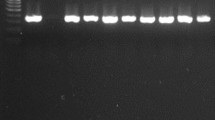Abstract
Electrophoretic karyotyping was used to compare DNA probes of yeasts isolated from blood of preterm neonates (n=66) in a neonatal intensive care unit (NICU) and from the hands of healthy hospital personnel (n=10). The yeasts were identified asCandida albicans using standard laboratory methods. DNA was extracted from yeasts and isolation of identical DNA strains from the pairs nurse-neonate suggested that one nurse transmitted one yeast strain by her hands to three neonates. Four neonates harbored two identical strains originating from two nurses,i.e. each nurse transmitted the same strain to two neonates. In the additional 7 cases transmission of 1 yeast strain by 1 nurse, to 1 neonate was observed. Our data suggest that nonperinatal nosocomial transmission ofC. albicans occurs in neonates. possiblyvia cross-contamination being transferred on hands of health care workers The importance of careful hand washing of staff (health care workers) and other infectioncontrol procedures (to prevent the nosocomial transmission of pathogens in the NICU environment) is emphasizeded.
Similar content being viewed by others
References
Berrouane Y.F., Hollis, R.J., Pfaller M.A.: Strain variation among and antifungal susceptibilities of isolates ofCandida krusei.J. Clin. Microbiol. 34, 1856–1858 (1996).
Diez B.R., Martinez V., Alvarez M., Tudela J.L.R., Suarez J.V.M.: Molecular tracking ofCandida albicans in a neonatal intensive care unit: long-term colonizations versus catheter-related infections.J. Clin. Microbiol. 35, 3032–3036 (1997).
Dorko, E., Kmeťová M., Pilipčinec E., Bračoková I., Dorko F., Danko J., Švický E., Tkáčiková L’.: Rare non-albicans Candida species detected in different clinical diagnoses.Folia Microbiol. 45, 364–368 (2000).
Fowler S.L., Rhoton B., Springer S.C., Messer S.A., Hollis R.J., Pfaller M.A.: Evidence for person-to-person transmission ofCandida lusitaniae in a neonatal intensive care unit.Infect. Control. Hosp. Epidemiol. 19, 343–345 (1998).
Haynes, K.A., Westerneng T.J.: Rapid identification ofCandida albicans, C. glabrata, C. parapsilosis andC. krusei by speciesspecific PCR of large subunit ribosomal DNA.J. Med. Microbiol. 44, 390–396 (1996).
Huang, Y.C., Lin T.Y., Leu H.S., Peng H.L., Wu J.H., Chang H.Y.: Outbreak ofCandida, parapsilosis fungemia in neonatal intensive care units: clinical implications, and genotyping analysis.Infection 27, 97–102 (1999).
Jautová J., Virágová S., Ondrašovič M., Holoda E.: Incidence ofCandida species isolated from human skin and nails: a survey.Folia Microbiol. 46, 333–337 (2001).
Khatib R., Thirumoorthi M.C., Riederer K.M., Sturm L., Oney L.A., Baran J. Clustering ofCandida infections in the neonatal intensive care unit: concurrent emergence of multiple strains simulating intermittent outbreaks.Pediatr. Infect. Dis. J. 17. 130–134 (1998).
Khoory B.J., Vino L., Dall’ Agnola A., Fanos V.:Candida infections in newborns: a review.J. Chemother. 11, 367–378 (1999).
Kossoff E.H., Buescher E.S., Karlowicz M.G.: Candidemia in a neonatal intensive care unit: trends during fifteen years and clinical features of 111 cases.Pediatr. Infect. Dis. J. 17, 504–508 (1998).
Levin A.S., Costa S.F., Mussi, N.S., Basso M., Sinto S.I., Machado C., Geiger D.C., Villares M.C., Schreiber A.Z., Barone A.A., Branchini M.L.:Candida parapsilosis fungemia associated with implantable and semiimplantable central venous catheters and the hands of healthcare workers.Diagn. Microbiol. Infect. Dis. 30, 239–243 (1998).
Narang A., Agrawal P.B., Chakrabarti A., Kumar P.: Epidemiology of systemic candidiasis in a tertiary care neonatal unit.J. Trop. Pediatr. 44, 104–108 (1998).
Noskin G.A., Lee J., Hacek D.M., Postelnick M., Reisberg B.E., Stosor V., Weitzman S.A., Peterson L.R.: Molecular typing for investigating an outbreak ofCandida krusei, Diagn. Microbiol. Infect. Dis. 26, 117–123 (1996).
Otčenášek M.:Identification Methods of Mycotic Infections (In Czech) Avicenum, Prague 1990.
Pfaller M.A., Messer S.A., Houston A., Rangel-Frausto M.S., Wiblin T., Blumberg H.M., Edwards J.E., Jarvis W., Martin M.A., Neu H.C., Saiman L., Patterson J.E., Dibb J.C., Roldan C.M., Rinaldi M.G., Wenzel R.P.: National epidemiology of mycoses survey: a multicenter study of strain variation and antifungal susceptibility among isolates ofCandida species.Diagn. Microbiol. Infect. Dis. 31, 289–296 (1998).
Rangel-Frausto M.S., Houston A.K., Bale M.J., Fu, C., Wenzel R.P.: An experimental model for study ofCandida survival and transmission in human volunteers.Eur. J. Clin. Microbiol. Infect. Dis. 13, 590–595 (1994).
Rangel-Frausto M.S., Wiblin T., Blumberg HM., Saiman L, Patterson J., Rinaldi M., Pfaller M., Edwards J.E., Jarvis W., Dawson J., Wenzel R.P.: National epidemiology of mycoses survey (NEMIS): Variations in rates of bloodstream infections due toCandida species in seven surgical intensive care units and six neonatal intensive care units.Clin. Infect. Dis. 29, 253–258 (1999).
Reef S.E., Lasker B.A., Butcher D.S., Mcneil M.M., Pruitt R., Keyserling H., Jarvis W.R.: Nonperinatal nosocomial transmission ofCandida albicans in a neonatal intensive care unit prospective study.J. Clin. Microbiol. 36, 1255–1259 (1998).
Ruiz-Diaz B., Martinez V., Alvarez M., Rodriguez-Tudela J.L., Martinez-Suarez J.V.: Molecular tracking ofCandida albicans in a neonatal intensive care unit: long-term colonizations versus catheter-related infections.J. Clin. Microbiol. 35, 3032–3036 (1997).
Singh K., Chakrabarti A., Narang A., Gopalan S.: Yeast colonization and fungemia in preterm neonates in a tertiary care centre.Indian J. Med. Res. 110, 169–173 (1999).
Trubenová D., Virágová S., Pilipčinec E., Danko J., Švický E., Tkáčiková L.: Candidaemia in cancer patients and in children in a neonatal intensive care unit.Folia Microbiol. 46, 161–164 (2001).
Vazquez J.A., Boikov D., Boikov S.G., Dajani A.S.: Use of electrophoretic karyotyping in the evaluation ofCandida infections in a neonatal intensive care unit.Infect. Control Hosp. Epidemiol. 18, 32–37 (1997).
Vazquez J.A., Dembry L.M., Sanchez V., Vazquez M.A., Sobel J., Dmuchowski C., Zervos M.A.: NosocomialCandida glabrata colonization: an epidemiologic study.J. Clin. Microbiol. 36, 421–426 (1998).
Waggoner-Fountain L.A., Walker M.W., Hollis, R.J., Pfaller M.A., Ferguson J.E., Wenzel R.P., Donowitz L.G.: Vertical and horizontal transmission of uniqueCandida species, to premature newborns.Clin. Infect. Dis. 22, 803–808 (1996).
Author information
Authors and Affiliations
Rights and permissions
About this article
Cite this article
Dorko, E., Virágová, S., Jautová, J. et al. Electrophoretic karyotyping ofCandida albicans strains isolated from premature infants and hospital personnel in a neonatal intensive care unit. Folia Microbiol 46, 453–457 (2001). https://doi.org/10.1007/BF02814438
Received:
Revised:
Issue Date:
DOI: https://doi.org/10.1007/BF02814438




